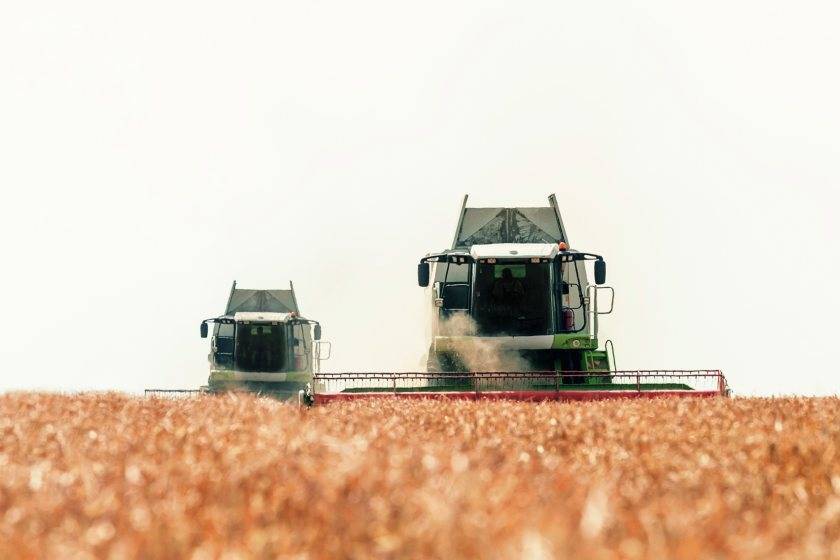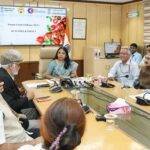Main Points In Hindi (मुख्य बातें – हिंदी में)
-
नई कृषि-तकनीक रणनीति की आवश्यकता: रिपोर्ट में बताया गया है कि 2013 में शुरू की गई पहली कृषि-तकनीक रणनीति के बाद, अगले दशक के लिए एक नई और स्पष्ट रणनीति की आवश्यकता है, जो कृषि की क्षमता को अनलॉक करने में मदद करेगी।
-
चुनौतियों की पहचान: कृषि-तकनीकी नवाचार के लिए चुनौतियों में बदलता हुआ निवेश परिदृश्य, राजस्व धाराओं की कमी, नियामक मुद्दे और समाधानों के विस्तार में कठिनाई शामिल हैं। नियामक व्यवस्थाओं की विफलता के कारण नवाचार प्रभावित हो रहा है।
-
पर्यावरणीय प्राथमिकताएँ: नई रणनीति में जलवायु-स्मार्ट कृषि और जैव विविधता की रक्षा के लक्ष्यों को शामिल किया जाना चाहिए। कृषि को पारिस्थितिकी सेवा और औद्योगिक उत्पादों के प्रमुख स्रोत के रूप में मान्यता दी जानी चाहिए।
-
निवेश और नवाचार: स्पष्ट और दीर्घकालिक रणनीतियाँ निजी निवेश को बढ़ावा दे सकती हैं और नवाचार के लिए एक रोडमैप प्रदान करेंगी। कृषि-तकनीक डेवलपर्स के लिए संभावित राजस्व धाराओं की कमी और तकनीकी अपनाने में कठिनाइयों का समाधान आवश्यक है।
- किसानों की अपेक्षाएं: रिपोर्ट में यह भी कहा गया है कि किसानों को तकनीकी समाधानों के लिए विश्वसनीयता की आवश्यकता है। उन्हें यह विश्वास दिलाने की आवश्यकता है कि नई तकनीकें प्रभावी होंगी, बजाय इसके कि उन्हें भविष्य में क्या हो सकता है के बारे में आश्वासन दिए जाएं।
Main Points In English(मुख्य बातें – अंग्रेज़ी में)
Here are the main points from the provided text:
-
Need for New Agricultural Technology Strategy: A report highlights the necessity for a new agricultural technology strategy over the next decade, following the initial strategy launched in 2013. This new strategy is crucial to unlock agricultural potential and address current challenges.
-
Challenges Identified: The report identifies several challenges within agricultural technology, including a changing investment landscape, difficulties in scaling solutions and businesses, lack of secure revenue streams, and regulatory failures to align with innovation.
-
Technological Advancements: Numerous advancements in technology, such as satellite imaging, GPS navigation, and clean energy production, have transformed the agricultural sector over the past decade, emphasizing the importance of continued innovations.
-
Role of Government and Regulatory Framework: It is essential for the government to recognize the broader contributions of the agricultural industry beyond just food production and to implement clear policies that encourage private investment and foster innovation.
- Need for Farmer-Centric Solutions: There is a call for realistic, reliable technological solutions that provide a clear return on investment for farmers, stressing the importance of farmers’ trust and the need for technology that works effectively from the outset.


Complete News In Hindi(पूरी खबर – हिंदी में)
एक रिपोर्ट में कहा गया है कि एक ताज़ा सरकारी कृषि-तकनीक रणनीति जो कई लाभ देने के लिए कृषि की क्षमता को अनलॉक करने में मदद करती है, अब अगले दशक के लिए महत्वपूर्ण है।
एग्री-टेकई की रिपोर्ट के अनुसार, 2013 में शुरू की गई पहली रणनीति के बाद अगले 10 वर्षों के लिए एक नई कृषि-तकनीक रणनीति की ‘स्पष्ट रूप से’ आवश्यकता है।
जबकि ब्रिटेन के अगले दशक और वैश्विक कृषि-तकनीक नवाचार के लिए ‘बहुत आशावाद’ है, रिपोर्ट में योगदानकर्ता चुनौतियों की भी पहचान करते हैं।
इनमें बदला हुआ निवेश परिदृश्य, समाधानों और व्यवसायों को बढ़ाने में कठिनाइयाँ, सुरक्षित राजस्व धाराओं की कमी और नवाचार के साथ तालमेल बिठाने में विफल रहने वाले नियामक शामिल हैं।
लेकिन उपग्रह इमेजिंग और जीपीएस नेविगेशन, स्वच्छ ऊर्जा उत्पादन, पशुधन पहनने योग्य वस्तुएं और पौधों और जानवरों की मेटागेनोमिक अनुक्रमण जैसे विकास से पता चलता है कि ‘पिछले दशक में कृषि कृषि तकनीक कैसे आई है’।
कृषि नवाचार को आगे बढ़ाने के लिए समर्पित एक गैर-लाभकारी संगठन, एग्री-टेकई की रिपोर्ट में 70 से अधिक योगदानकर्ताओं की प्रतिक्रियाएं शामिल हैं, जिन्होंने इसे आकार देने में मदद की।
एग्री-टेकई निदेशक डॉ बेलिंडा क्लार्क ने कहा: “2013 की रणनीति ने कृषि और बागवानी क्षेत्रों में बहुत सारी नई सोच, ऊर्जा, बाहरी निवेश और नवाचार को जन्म दिया।
“लेकिन यह क्षेत्र अब बहुत अलग जगह पर है और कृषि-तकनीक के भविष्य को आकार देने के लिए नई सरकार के फोकस की जरूरत है ताकि इस क्षेत्र को नई प्राथमिकताओं को पूरा करने में मदद मिल सके।”
इनमें उत्सर्जन को कम करने के लिए जलवायु-स्मार्ट कृषि पर अधिक जोर देना और जैव विविधता में गिरावट को रोकने और साफ पानी और हवा को बनाए रखने में मदद करने के लिए पर्यावरणीय संवेदनशीलता के साथ कृषि उत्पादकता को संरेखित करना शामिल है।
सरकार को यह भी समझना चाहिए कि उद्योग सिर्फ भोजन के अलावा ‘बहुत अधिक’ वितरित करता है, जिसमें पारिस्थितिकी तंत्र सेवाएं और जैव ईंधन, फार्मास्यूटिकल्स और कपड़ा और निर्माण के लिए कच्चे माल जैसे औद्योगिक फीडस्टॉक शामिल हैं।
डॉ. क्लार्क ने कहा, “हमें कृषि और बागवानी के लिए एक ऐसी रणनीति देने के लिए नई सरकार की आवश्यकता है जो उद्योग को हमारी जैव-अर्थव्यवस्था के प्रमुख घटक के रूप में मान्यता दे।”
“यह, बदले में, उद्योग की क्षमता को अनलॉक करने के प्रमुख समर्थकों में से एक के रूप में एक ताज़ा कृषि-तकनीक रणनीति को सूचित करेगा।”
उन्होंने कहा, स्पष्ट नीतियां यात्रा की दिशा में स्पष्टता देती हैं और आत्मविश्वास पैदा करती हैं, उन्होंने कहा कि अगले दशक के लिए एक नई रणनीति की जरूरत है।
डॉ. क्लार्क ने समझाया, “अच्छी तरह से परिभाषित, दीर्घकालिक क्षेत्र रणनीतियाँ निजी निवेश को बढ़ावा दे सकती हैं और नवाचार की सफलता के लिए एक रोडमैप प्रदान कर सकती हैं।”
रिपोर्ट में पहचानी गई कृषि-तकनीक कंपनियों के लिए अन्य चुनौतियों में से एक यह है कि नवाचार के साथ तालमेल बिठाने में विनियमन कैसे विफल हो रहा है।
इसका एक उदाहरण जैविक उत्पादों के उपयोग जैसे उभरते रुझानों के लिए स्पष्ट विनियमन की कमी है।
रिपोर्ट से पता चलता है कि कृषि-तकनीक डेवलपर्स के लिए, नवाचार की शुरुआत से ही नियामकों के साथ जुड़ाव महत्वपूर्ण है।
स्केलिंग समाधान भी चुनौतीपूर्ण बने हुए हैं, जिन्हें व्यवसायों के लिए अधिक सरकारी समर्थन के माध्यम से कम से कम आंशिक रूप से मदद की जा सकती है, संभावित रूप से उभरते उद्योगों को बढ़ावा देने के लिए अनुबंध या सब्सिडी के माध्यम से।
एग्री-टेकई बताते हैं कि सुरक्षित राजस्व धाराओं के बिना, बाजारों में प्रवेश करना कठिन हो सकता है।
समान रूप से महत्वपूर्ण बात यह है कि, कृषि-तकनीक डेवलपर्स किसानों के लिए निवेश पर रिटर्न की गणना करने के लिए संघर्ष कर रहे हैं – किसानों के लिए यह तय करने के लिए महत्वपूर्ण जानकारी कि नई तकनीक को अपनाना है या नहीं।
रिपोर्ट से पता चलता है कि इससे कुछ ‘ऑन-फ़ार्म थकान’ हो रही है, साथ ही कुछ प्रौद्योगिकियाँ और व्यवसाय अपने प्रचार को पूरा करने में विफल हो रहे हैं।
डॉ. क्लार्क ने ज़ोर देकर कहा, “हमें किसानों से यह वादा करना बंद करना होगा कि एक तकनीक कल दुनिया को बदल देगी।”
“जबकि कुछ किसान बीटा-टेस्टर बनकर खुश हैं, अधिकांश विश्वसनीयता चाहते हैं और ऐसे समाधान तलाशते हैं जो पहली बार काम करें।”
Complete News In English(पूरी खबर – अंग्रेज़ी में)
A report has stated that a new government agricultural technology strategy, which helps unlock the potential of agriculture for various benefits, is crucial for the next decade.
According to Agri-Tech East’s report, there is a clear need for a new agricultural technology strategy for the next 10 years following the first one launched in 2013.
While there is much optimism about Britain’s agricultural technology innovation for the next decade, contributors to the report also identify several challenges.
These challenges include a changed investment landscape, difficulties in scaling solutions and businesses, a lack of secure revenue streams, and regulators who fail to keep pace with innovation.
However, developments like satellite imaging, GPS navigation, clean energy production, wearable tech for livestock, and metagenomic sequencing for plants and animals indicate how agricultural technology has evolved over the past decade.
The report includes feedback from over 70 contributors aimed at advancing agricultural innovation, based on insights from a non-profit organization, Agri-Tech East.
Dr. Belinda Clark, director of Agri-Tech East, noted that the 2013 strategy brought about a lot of new ideas, energy, external investment, and innovation in agriculture and horticulture.
“But the sector is now in a very different place, and new government focus is required to shape the future of agricultural technology to help meet new priorities,” she said.
These priorities include a greater emphasis on climate-smart agriculture to reduce emissions and aligning agricultural productivity with environmental sensitivity to help prevent biodiversity loss and maintain clean water and air.
The government also needs to recognize that the industry delivers “much more” than just food, including ecosystem services, biofuels, pharmaceuticals, and raw materials for textiles and construction.
Dr. Clark emphasized the need for a strategy that acknowledges agriculture and horticulture as key components of our bio-economy.
“This, in turn, will inform a fresh agricultural technology strategy as one of the key enablers to unlock the industry’s potential,” she added.
She stated that clear policies provide direction and build confidence, highlighting the necessity for a new strategy for the next decade.
Dr. Clark explained that well-defined, long-term sector strategies can encourage private investment and provide a roadmap for innovation success.
The report identifies additional challenges for agricultural technology companies, including how regulation is failing to keep pace with innovation.
One example is the lack of clear regulation for emerging trends such as the use of organic products.
The report indicates that for agricultural technology developers, engaging with regulators early in the innovation process is crucial.
Scaling solutions remains a challenge, which could be partially alleviated through increased government support, potentially via contracts or subsidies to promote emerging industries.
Agri-Tech East points out that without secure revenue streams, entering markets can be difficult.
Equally important, agricultural technology developers are struggling to provide farmers with the information needed to calculate returns on investment, which is vital for farmers in deciding whether to adopt new technologies.
The report suggests that this challenge is causing some “on-farm fatigue,” and some technologies and businesses are failing to deliver on their promises.
Dr. Clark stressed the need to stop making promises to farmers that a technology will change the world overnight.
“While some farmers are happy to be beta testers, most want reliability and solutions that work the first time,” she concluded.




